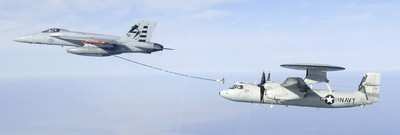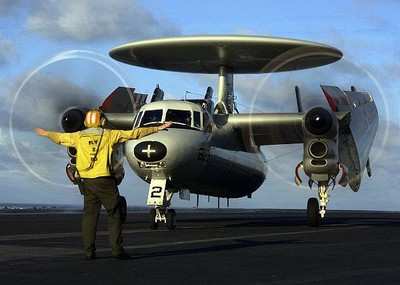 NAVAIR, for the first time, has
demonstrated the Navy’s premier command-and-control
aircraft's potential to refuel and stay in action longer.
NAVAIR, for the first time, has
demonstrated the Navy’s premier command-and-control
aircraft's potential to refuel and stay in action longer.
During flight tests in December and early January, the Hawkeye
program (PMA-231) fitted an E-2C with a refueling test probe and
successfully connected to tanker aircraft over the skies of
Patuxent River Naval Air Station, Md. Test and evaluation squadron
VX-20 conducted the simulations using the Navy's KC-130 and newest
tanker aircraft, the F/A-18E Super Hornet.
VX-20’s testing event marks the first time that a Navy E-2
demonstrated plugging to the basket. The E-2 aircraft sported a
test probe - half of the refueling probe and drogue (basket) system
used on a variety of Navy tactical aircraft today.
“Joint commanders rely heavily upon the E-2 for
command-and-control operations during in-theatre missions.
Refueling increases the E-2’s endurance and broadens its
presence,” said Capt. Randy Mahr, PMA-231 Program
Manager.

“By examining the E-2’s role in the Global War on
Terrorism as well as here at home in support of Katrina relief, we
know the benefits could be of great significance.”
“In situations where there is a NEED to be there, it is
always better to be able to STAY there,” said E-2 pilot Lt.
Cmdr. Hugh Winkel.
Program engineer Chris Gay said if the Navy formalizes a
refueling program for the E-2, more follow-on testing will include
evaluating the performance during unusual or difficult
operations.
“These tests would be performed in less-than-ideal weather
conditions and mission scenarios with a variety of tanker
aircraft,” said Jason Brys, another program engineer.
During testing, the aircraft plugged into the basket without
actually refueling, to evaluate flying qualities, noise, field of
view and basket movement during the normal process of transferring
fuel. The team made 16 successful connections with a KC-130 Dec. 19
and connected with a Super Hornet from Patuxent River test and
evaluation squadron VX-23 in a flight lasting just over an hour
Jan. 5.

The program will evaluate testing results to determine whether
it is beneficial to create a full testing program.
The program looks to E-2 aviators when evaluating mission
aircrew requirements. If implemented, the new refueling capability
will appear first on the fleet’s E-2C Hawkeye 2000 variant.
The E-2D would receive the probe as a retrofit following the
Advanced Hawkeye’s initial production, which is currently
underway at Northrop Grumman’s St. Augustine, Fla. plant.
Refueling has been a concept circulating in the E-2 community
for some time, including previous tests executed with limited
instrumentation and without using a probe. Test goals were achieved
by simulating the refueling pre-contact position behind the basket
with no temperature rise to the aircraft. This was a precursor to
current testing in which crews used an E-2 equipped with testing
instrumentation. During the recent flights, the team attached photo
markers to the E-2 structure to help photographically measure
aircraft position while recording temperatures and pressures and
other test indicators of interest to the team.

“This success is part of our team’s continuing
contribution to the Navy-wide goal of delivering the right force,
with the right readiness, and at the right cost,” said Rear
Adm. David Venlet, Program Executive Officer for Tactical Aircraft
Programs. Venlet oversees the efforts of PMA 231.
“You’ll see much more of this as the Naval Aviation
Enterprise continues to streamline development and procurement of
the systems we send forward to our fleet warfighters.”
 ANN's Daily Aero-Term (12.13.25): Light Gun
ANN's Daily Aero-Term (12.13.25): Light Gun Aero-News: Quote of the Day (12.13.25)
Aero-News: Quote of the Day (12.13.25) NTSB Final Report: Gippsland GA-8
NTSB Final Report: Gippsland GA-8 Classic Aero-TV: Historically Unique -- Marlin Horst's Exquisite Fairchild 71
Classic Aero-TV: Historically Unique -- Marlin Horst's Exquisite Fairchild 71 Airborne 12.12.25: Global 8000, Korea Pilot Honors, AV-30 Update
Airborne 12.12.25: Global 8000, Korea Pilot Honors, AV-30 Update






